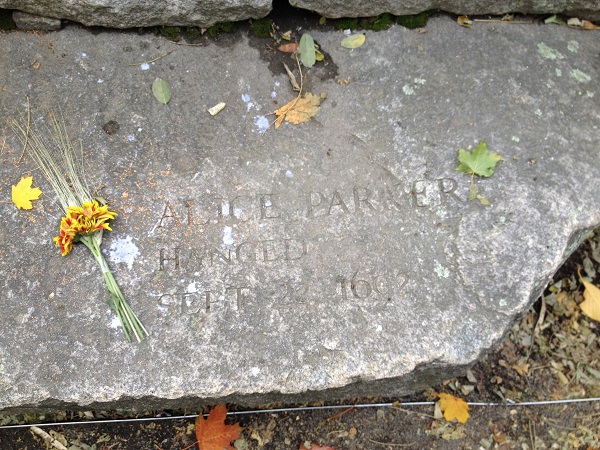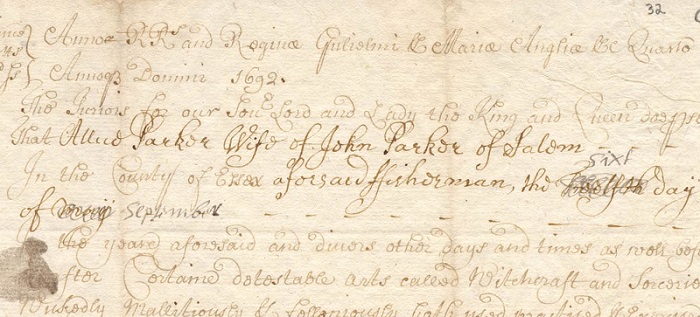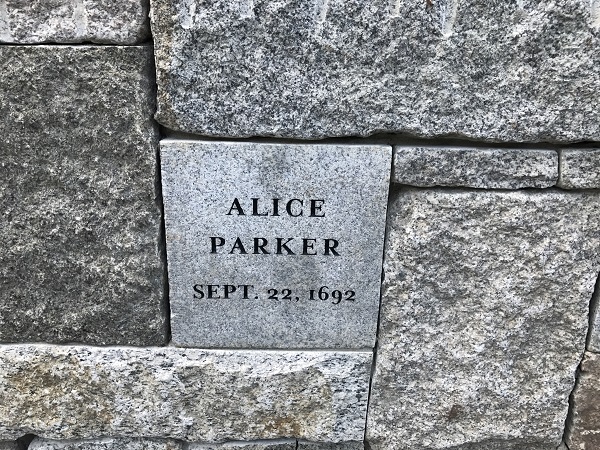Alice Parker was a woman from Salem who was accused of witchcraft during the Salem Witch Trials.
Parker was married to a fisherman named John Parker at the time of the Salem Witch Trials. The couple lived in a rented house, owned by Mary English, on English street in Salem town.
Some sources believe that Alice Parker may have been the daughter or stepdaughter of Giles Corey, because Corey had a daughter who was married to a man named John Parker, according to Elizabeth Reis in her book Spellbound: Women and Witchcraft in America:
“The Alice Parker who was executed in 1692 may or may not have been Giles Corey’s daughter. Both a Mary Parker of Andover and an Alice Parker, wife of John Parker, of Salem, were hanged as witches that year. Giles (and his former wife Mary) had a daughter who was married to John Parker of Salem, but her name was usually given as Mary. Names like Mary and Alice were sometimes used interchangeably in early New England, and I suspect that the Alice Parker who was executed was in fact Giles Corey’s daughter” (Reis 22).
Yet, Historian Marilynne K. Roach states in her book, Six Women of Salem, that Corey’s son-in-law was a different John Parker who worked as a farmer, not a fisherman.
Alice Parker & the Salem Witch Trials:
Alice Parker was accused of witchcraft by Mary Warren during Warren’s examination on May 12, 1692.
During the examination, Warren stated that Alice Parker and Ann Pudeator were both witches and had actively hurt people, according to the court records:
“Goody Parker told me she had been a witch these 12 years & more; & Pudeator told me that she had done damage, & told me that she had hurt James Coyes child taking it out of the mothers hand” (SWP No. 135.4).
Warren said that Parker also brought her a poppet of Mercy Lewis and taught her how to afflict Lewis with it and that her specter appeared to her in jail and told her she was coming there soon.
As a result of Warren’s accusations, Parker and Pudeator were arrested that same day and examined in court.

At the examination, Parker pled not guilty to all of the accusations and charges and denied even knowing Warren, according to the court records:
“Q: Mary Warren charges you with several acts of witchcraft, what say you to it guilty or not?
A: I am not guilty.
Q: You told her this day you cast away Thomas Westgate.
A: I know nothing of it.
Q: You told her John Lapthorn was lost in [illegible]
A: I never spoke a word to her in my life.
Q: You told her also you bewitched her sister, because her father would not mow your grass.
A: I never saw her.”
(SWP No. 97.1)
When Mary Warren asked the judges if she could strike Alice Parker, which they permitted, Warren approached Parker she fell backwards into a fit.
Margaret Jacobs also testified at the examination and stated that she saw Parker’s specter in the north field last Friday night.
Marshal Herrick testified that when he arrested Parker, she told him that there were “threescore witches of the company.” Another person, John Louder, had overheard this exchange and confirmed it for the court. Parker didn’t deny making this statement but stated that she couldn’t remember how many she said there were.
Mary Warren testified that her father had once promised Alice Parker that he would mow her grass for her (meaning harvest her crop of hay) but failed to do so, after which Parker came to her house and demanded that he do it. After this exchange, Mary’s mother and sister became ill and her mother later died.
Warren then stated that Parker had also brought her a poppet and instructed her to stick it with a needle and also stated that Parker told her she attended a bloody sacrament in Reverend Samuel Parris’s pasture with 30 other witches.
Another noteworthy piece of testimony came from Reverend Noyes who suggested that Parker might be a heretic, according to Charles W. Upham in his book Salem Witchcraft:
“There is one item in reference to Alice Parker, which indicates that the zeal of the prosecutors in her case, as in that of Mr. Burroughs, and perhaps others, was aggravated by a suspicion that she was heretical on some points of the prevalent creed of the day. Parris says that ‘Mr. Noyes, at the time of her examination, affirmed to her face, that, he being with her at a time of sickness, discoursing with her about witchcraft, whether she were not guilty, she answered, ‘if she was as free from other sins as from witchcraft, she would not ask of the Lord mercy.’ The manner of expression in this passage shows that it was thought that there was something very shocking in her answer. Mr. Noyes ‘affirmed to her face.’ No doubt it was thought that she denied the doctrine of original and transmitted, or imputed sin” (Upham 185).
At this point of the examination, Warren’s seizures became so severe that her tongue stretched out of her mouth and turned black, to which Parker stated that the girl’s tongue would become blacker before she died.
After the examination was over, Alice Parker was indicted on two charges of witchcraft for afflicting Mary Walcott and Mary Warren and brought back to the Salem jail.
On May 13, Alice Parker was transferred to the Boston jail, along with Ann Pudeator, Mary English, Nathaniel Putnam’s slave Mary, Sarah Wildes, Bridget Bishop, Sarah Bishop, Edward Bishop, William Hobbs, Giles Corey and George Jacobs Sr.
For reasons that are unclear, Parker was examined for a second time on September 6, 1692. Historian Marilynne K. Roach suggests, in her book Six Women of Salem, that a possible reason for this is that Parker may have been released from jail and then arrested again, much like Ann Pudeator and Mary Easty had been.
The record of the second examination has been lost but the testimony of the afflicted girls and others from the following day still exists.
Numerous people testified against Alice Parker on September 7, including Martha Dutch, Thomas Putnam, William Murray, John Westgate, John Bullock as well as the afflicted girls Sarah Bibber, Mary Walcott, Elizabeth Hubbard, Ann Putnam Jr, Mary Warren and Abigail Hobbs.
Martha Dutch testified that during a conversation with Parker two years ago Parker told Dutch that her husband, who was a mariner, would not return home from sea, according to the court records:
“This deponent did say unto the said Parker that I did hope he would come home this voyage well also & the said Parker made answer unto me & said no no never more in this world the which came to pass as she then told me for he died abroad as I certainly hear” (SWP No. 97.4).
A man named John Westgate testified that eight years ago he was drinking with John Parker at Beadle’s Tavern when Alice Parker stormed in and chided her husband for being there. When Westgate criticized her for her behavior, she called Westgate a rogue and told him to mind his own business.
Westgate said that shortly after the incident, he was walking home when he suddenly saw a black hog running towards him which startled him so much he fell down and his knife stabbed him in the hip. Westgate said he crawled all the way home, with the black hog following him the whole way, and when he got home he saw that his knife had shattered and his stocking and shoe was full of blood, all of which made him determined that the hog was “either the Devil or some evil thing not a real hog, and did then really judge or determine in my mind that it was either Goody Parker or by her means, and procuring that she is a witch” (SWP No. 97.7).
John Bullock testified that in the middle of January last year he found Alice Parker unconscious and laying in the snow and after some neighbors carried her home she suddenly woke up and laughed in their faces.
Martha Dutch confirmed Bullock’s story by saying she had seen Parker in that condition several times, which suggests that Parker may have suffered from some sort of chronic medical condition.
The afflicted girls testified that Alice Parker attacked Mary Warren, Ann Putnam Jr and Mary Walcott last night in the courtroom during her examination by choking and squeezing them and by grabbing Mary Warren around the waist.
Mary Warren also testified that Alice Parker tried to get her to sign the Devil’s book, brought her a poppet and threatened to stab her if she didn’t stick the poppet with a needle.
Warren also accused Parker of drowning several people at sea, including Thomas Westgate and his crew, as well as the son of Goody Ornes and a man named Michael Chapman, who drowned in Boston harbor. Warren said Parker also caused the death of John Searles’s son and her mother and caused her sister to go deaf.
Thomas Putnam and William Murray also testified that they had witnessed Mary Walcott and Mary Warren and others being afflicted during Parker’s examination last night and observed that upon several glances from Parker the girls were stuck down and that after Parker laid her hand upon them, during a “touch test,” they recovered, thus convincing them “that Alice Parker the prisoner at the bar has often hurt the said persons by acts of witchcraft” (SWP No. 97.6).
According to Roach, from looking at the original court documents, after all of the testimony was heard it appears that the court clerk crossed out the original May 12 date on Alice Parker’s two indictments and changed the date to September 6 instead:
“When the grand jury indicted Alice Parker on September 7 for tormenting Mary Walcott and Mary Warren, the latest spectral attacks counted for more than the similar assaults in May, so the clerk adjusted the date on the documents from May 12 to September 6.”

On September 9, 1692, the court of Oyer and Terminer met again, at the Salem courthouse on what is now Washington Street, and heard Alice Parker’s case as well as many others.
After hearing all of the testimony for Parker’s case, the jury found Alice Parker guilty of witchcraft and sentenced her to death.
The Execution of Alice Parker:
On Thursday, September 22, 1692, Alice Parker was brought to the execution site at Proctor’s Ledge in Salem, along with Mary Easty, Ann Pudeator, Martha Corey, Margaret Scott, Wilmot Redd, Mary Parker and Samuel Wardwell.
As the cart carrying the prisoners crossed the causeway over the North River and turned up the steep hill, it suddenly became stuck as it started to ascend the hill.
The law men struggled to get the wheels to move, while the afflicted girls began to cry out that they saw the Devil holding the cart back (Calef 218.) Eventually, the oxen pulled the cart free and they arrived at Proctor’s Ledge.
According to Upham, in his book Salem Witchcraft, the prisoners continued to declare their innocence at the execution:
“Nothing has reached us particularly relating to the manner of death of Alice or Mary Parker, Ann Pudeator, Margaret Scott, or Wilmot Reed. They all asserted their innocence; and their deportment gave no ground for any unfavorable comment by their prosecutors, who were on the watch to turn every act, word, or look of the sufferers to their disparagement” (Upham 325).
After all the prisoners were executed and their bodies were still hanging, Reverend Nicholas Noyes, who had officiated as clergyman at the hangings that day, remarked “what a sad thing it is to see eight firebrands of hell hanging there” (Calef 221). These were the last executions of the Salem Witch Trials.

The victims were then cut down and temporarily placed in a nearby rocky crevice. It is not known what happened to their bodies after that.
Parker’s Family After the Salem Witch Trials:
In 1710, after a number of the surviving accused witches filed petitions with the Massachusetts General Court asking that their names be cleared, the Massachusetts legislature appointed a committee to go to Salem and make restitution to the victims and their families.
In September of that year, the committee made a six-day visit to Salem, during which it received 45 petitions from victims and their families asking for restitution and requesting that their names to be cleared. For reasons unknown, none of Alice Parker’s relatives filed a petition with the court.
Realizing that some of the accused were not represented, a member of the Massachusetts General Court, Nehemiah Jewett, sent a letter to Judge Samuel Sewall, a member of the committee, asking that their cases be considered as well, according to court records:
“Mr. Sewall Sir I thought good to return you the names of several persons that were condemned & executed that not any person or relations appeared in the behalf of for the taking of the attainder or for other expenses. they I suppose were returned to the General Courts consideration for to act about according to their best prudence. Bridget Bishop alias Oliver, Susanna Martin, Alice Parker, Ann Pudeator, Wilmot Read, Margaret Scott. Sir. I am yours Honors to serve Neh Jewet” (SWP No. 173.44).
Jewett’s letter seemed to have no effect because, on October 17, 1711, the Massachusetts Legislature passed a law clearing the names of many of the accused, except for Alice Parker, Bridget Bishop, Susanna Martin, Ann Pudeator, Wilmot Redd and Margaret Scott, according to Emerson Baker in his book A Storm of Witchcraft:
“After the acts of 1703 and 1711, all attainders had been reversed and only seven convictions for witchcraft remained in place. Six involved the executed Bridget Bishop, Susannah Martin, Alice Parker, Ann Pudeator, Wilmot Redd, and Margaret Scott….In the case of the six executed witches, no one had come forward to ask for their reversals, so the General Court took no action” (Baker 249).
In 1957, Massachusetts apologized for the events of 1692 and cleared the name of “One Ann Pudeator and certain other persons” yet still did not mention Alice Parker’s name.
On October 31, 2001, the Massachusetts legislature amended the 1957 apology and officially exonerated five victims not named in the 1711 bill or in the 1957 apology: Alice Parker, Bridget Bishop, Susannah Martin, Wilmot Redd and Margaret Scott.

In 1992, the Salem Witch Trials Memorial was built in Salem, Mass and a marker was established for Alice Parker.
In 2017, the Proctor’s Ledge Memorial was built in Salem, Mass and a marker was established for Alice Parker.
Alice Parker Historical Sites:
Former Site of Parker Family Home
Address: English Street, Salem, Mass. Exact location is believed to have been in what is now the parking lot of the Salem Harbor Power Station.
Salem Witch Trials Memorial
Address: Liberty Street, Salem Mass
Proctor’s Ledge Memorial
Address: 7 Pope St, Salem, Mass
Site of the Salem Witch Trials Executions
Address: Proctor’s Ledge, wooded area between Proctor Street and Pope Street, Salem, Mass
Former Site of the Salem Courthouse
Address: Washington Street (about 100 feet south of Lynde Street), opposite the Masonic Temple, Salem, Mass. Memorial plaque located on Masonic Temple.
Former Site of the Salem Jail
Address: 4 Federal Street, Salem, Mass. A large brick building now stands on the spot and it has been renumbered 10 Federal Street. Memorial plaque located on the building.
Sources:
Reis, Elizabeth. Spellbound: Women and Witchcraft in America. SR Books, 1998.
Baker, Emerson W. A Storm of Witchcraft: The Salem Witch Trials and the American Experience. Oxford University Press, 2014.
Roach, Marilynne K. Six Women of Salem: The Untold Story of the Accused and Their Accusers in the Salem Witch Trials. Da Capo Press, 2013.
Upham, Charles W. Salem Witchcraft: With An Account of Salem Village and a History of Opinions on Witchcraft and Kindred Subjects. Vol. II, Boston: Wiggin and Lunt, 1867.
Calef, Robert. More Wonders of the Invisible World. Salem: Cushing and Appleton, 1823.
“Arrest Warrant for Alice Parker and Ann Pudeator.” Hawthorne in Salem, www.hawthorneinsalem.org/images/image.php?name=MMD2570
“Massachusetts Clears 5 From Salem Witch Trials.” New York Times, 2 Nov. 2001, nytimes.com/2001/11/02/us/massachusetts-clears-5-from-salem-witch-trials.html
“SWP No. 135: Mary Warren.” Salem Witch Trials Documentary Archive and Transcription Project, salem.lib.virginia.edu/n135.html
“SWP No. 097: Alice Parker Executed, September 22, 1692.” Salem Witch Trials Documentary Archive and Transcription Project, salem.lib.virginia.edu/n97.html
“Alice Parker Home, Site Of.” Salem Witch Museum, salemwitchmuseum.com/locations/alice-parker-home-site-of/

Here’s a hopefully welcome surprise for you. I was born Alice Marie Parker in 1964 in Lakeland FL. Many years ago my brother John Parker says he did a book report for school and found my name as murdered in the Salem witchcraft trials (I have been called worse). Many farmers/grove workers in the family for generations (Parkers). I married a John (Richards) and had son John, know people named English, Roach, Putnam, Hubbard, Warren, Chapman…my mom says 100+ years ago my (great+) grandmothers were midwives/medical herbs/farmers in Ohio/Michigan area. Other info I will not post. Am curious for contact from you, and will delete/block others. Thank you.
Hello Alice we could be related my name is Hailey Parker I was born December 13, 2007. My mom’s name is Staci Parker she was born September 7, 1986
I am off your lineage and some weird suit has been going on that led to me discovering this.. Get in touch with me if you can help me understand more.. my fathers name is Michael Chapman aka Michael Parker… My Mothers name is Donna Scearcy I am of Nathaniel Hawthornes lineage as well.